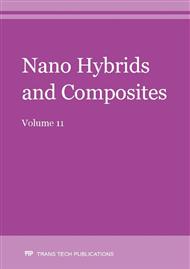p.1
p.7
p.22
p.30
p.38
Surface Engineering of Magnetite Nanoparticles by Plant Protein: Investigation into Magnetic Properties
Abstract:
The surface of the magnetite nanoparticles has been engineered by the proteins available in the leaf extract of Datura inoxia. Fourier Transform Infrared (FTIR) study and by thermo gravimetric analysis (TGA) confirms the bonding between metal ions and the amide carbonyl group preset in the plant protein confirming the formation of core-shell structure. The plant protein coated magnetic Fe3O4 nanoparticles under investigation have an average size of about 14 nm (˂20nm). The isothermal magnetization curve of the ferrofluid appears in S-like sigmoid shape showing soft nonhysteretic magnetic behaviour at room temperature. The saturation magnetization (MS), remanent magnetization (MR), squareness (MR/MS) and coercivity value (HC) increased with decreasing temperature from 300 K to 10 K. The increment of magnetization (45 to 53 emu/gm) might be due to the decrease in thermal energy while the enhancement of coercivity (0-208 Oe) is attributed to the exchange interaction at the interface between the ferromagnetic (Fe3O4) and diamagnetic surface layer of protein on the nanocrystalline magnetite. The magnetization value is much smaller in comparison with the bulk magnetite (92emu/g) due to surface spin disorder also approves core-shell structure of diamagnetic protein layer on the surface. The results show the ease of the synthesis to reinforce the colloidal stability where the super paramagnetic behaviour has been found to be restored. The core-shell moiety could play an important role in biological systems as a means of storing Fe+3 for an organism.
Info:
Periodical:
Pages:
38-44
Citation:
Online since:
October 2016
Authors:
Price:
Сopyright:
© 2016 Trans Tech Publications Ltd. All Rights Reserved
Share:
Citation:


